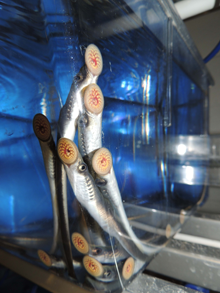Call it the reverse spy problem. If you were a spy who wanted to gain access to a top secret weapons factory, your task would be to fit in. The details of your employee badge, for example, should look just right.
As described in this 2016 JCI Insight paper, Emory and University of Toronto investigators wanted to do the opposite. They were aiming to develop antibody tools for studying and manipulating plasma cells, which are the immune system’s weapons factories, where antibody production takes place. The situation is flipped when we’re talking about antibodies. Here, the goal is to stand out.

Do these guys look like good spies?
Monoclonal antibodies are classic biomedical tools (and important anticancer drugs). But it’s tricky to develop antibodies against the places where antibodies themselves are made, because of the way the immune system develops. To guard against autoimmune disease, antibodies that would react against substances in the body are often edited out.
To get around this obstacle, researchers used organisms that have very different immune systems from humans: lampreys. Emory’s Max Cooper and colleagues had already shown how lampreys have molecules — variable lymphocyte receptors or VLRs — that function like antibodies, but don’t look like them, in terms of their molecular structure.
From the paper:
We reasoned that the unique protein architecture of VLR Abs and the great evolutionary distance between lampreys and humans would allow the production of novel VLRB Abs against biomedically relevant antigens against which conventional Abs are not readily produced because of structural or tolerogenic constraints.
Senior author Goetz Ehrhardt, now at University of Toronto, used to be in Cooper’s lab, and their two labs worked together on the JCI Insight paper.
The authors explain how lampreys were immunized with bone marrow cells from a multiple myeloma patient, and then VLR genes were isolated from the lampreys. The researchers then picked out an individual VLR that reacted specifically with plasma cells, but not other cell types.
Protein analysis revealed that the VLR recognizes a molecule called CD38. The lamprey VLR recognizes a unique structural feature, or epitope, of CD38 found only on plasma cells. CD38 appears on other immune cell types as well.
It turns out that CD38 is also the target of daratumumab, a more conventionally-derived (ie, no lampreys involved) antibody that is now FDA-approved for the treatment of multiple myeloma. This shows that the lamprey immunization route did not produce a fluke.
Lampreys’ immuno-molecular distinctiveness is the rationale for a start-up company called Novab. Cooper says that his lab and Ehrhardt’s continue to work together on similar lamprey VLRs, with possible future use by Novab. This article on work by another one of Cooper’s alumni, the late Zeev Pancer, uses the term “lambodies” (lamprey antibodies).
In Emory’s Department of Pediatrics, Trent Spencer and colleagues have been investigating lamprey VLRs as possible steering wheels for chimeric antigen receptor T cells, the much-touted cancer immunotherapy.

